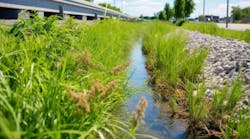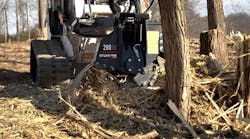Deserts are an alien environment to me. As I’ve mentioned on this blog before, I grew up in the lush rainforests of the Pacific Northwest, so deserts can seem a little barren. Low, prickly vegetation covers dry, dusty soil, and there’s so much sky—the large boulders and intermittent trees don’t offer the amount of shade I’m used to. But it turns out there’s a surprising source of life in this ecosystem, if you just know where to look—right under your feet.
In many ecosystems with relatively low biomass, like deserts and tundra, the surface of the soil forms a biological soil crust (biocrust) made up of algae, lichen, moss, cyanobacterial. Like other soils and plant materials, biocrusts store carbon and reflect sunlight, but they also hold the soil together and prevent erosion. Plants rely on biocrusts for the water and nutrients they need, and animals rely on the plants. Without the biocrust, the ecosystem is much more vulnerable to erosion, vegetation loss, and extreme heat.
An article last week in High Country News reports that the loss of biocrust in Bandelier National Monument is not only endangering the local ecosystem, but also the carved cave homes of the Ancestral Pueblo. European livestock grazing and logging practices, drought, and bark beetles damaged the biocrust and killed most of the pines in the park, and, as a result, little could grow on the unshaded ground. According to the article, “Together, these impacts now cause an astonishing 8,900 pounds of soil per acre to erode each year.”
Scientists have tried grafting lab-grown biocrusts in the wild, but the process so far has not been successful. It turns out that biocrusts take a long time to rebound. The article above reports that some grow back on their own in less than 20 years, which already sounds like a long time until you hear about General Patton. According to the article, General George Patton drove tanks through the Mojave Desert as part of a training exercise in WWII, leaving tracks in the soil. Researchers have compared the tank tracks to nearby untouched soil and, based on how the tracks have recovered in the ensuing half-century, estimate a full recovery could take nearly 2,000 years.
Some conservationists argue that focus should be directed towards minimizing destruction rather than on re-establishing biocrusts, but scientists like Kristina Young, a Ph.D. student at the University of Texas at El Paso, continue to experiment with soil type and different species of algae, cyanobacteria, and lichen in hopes of achieving a successful biocrust graft. “When you start losing soil from an ecosystem, you can start to erode the whole system,” she told High Country News.
Do you think our energy and money are best spent on preserving the soil we have or rehabilitating degraded soil? Or both? Send your thoughts, comments, and experiences with soil regeneration to [email protected].






